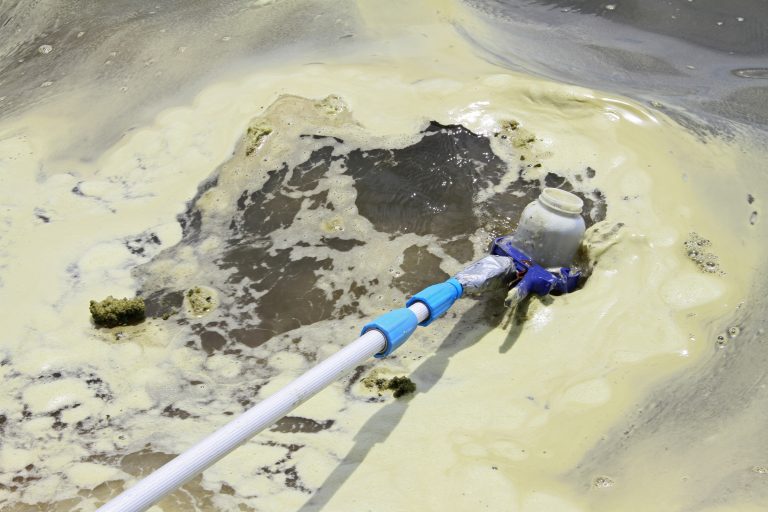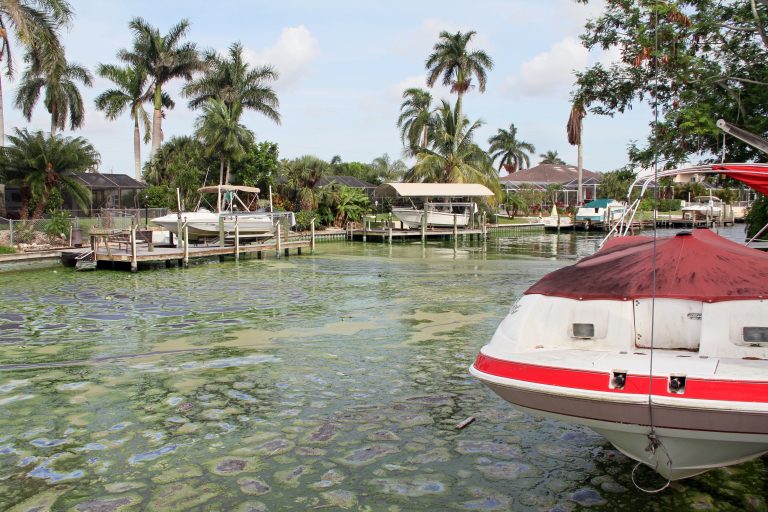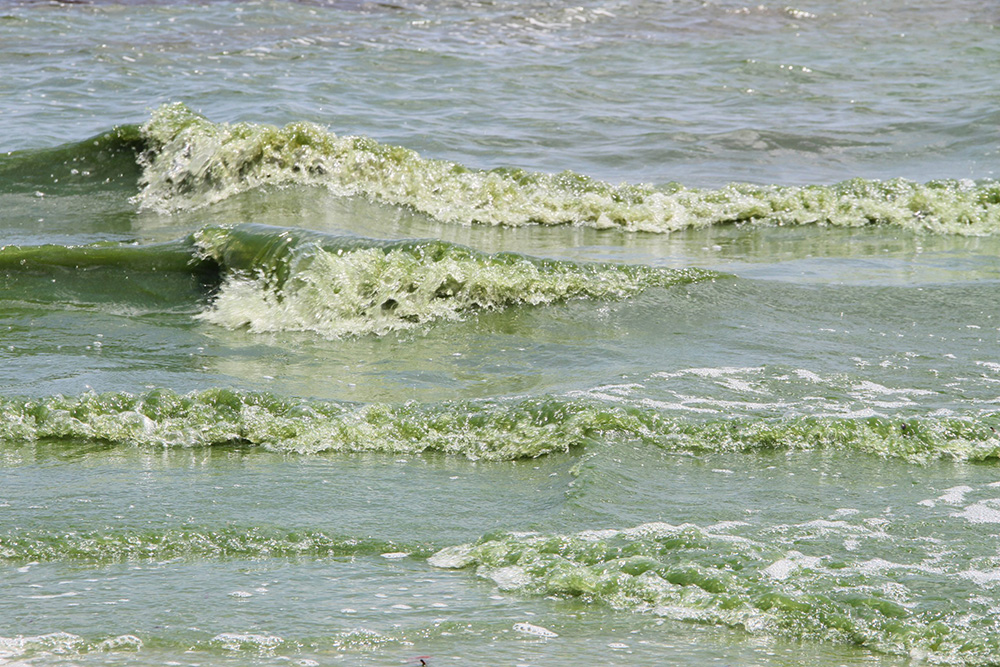ST. PETERSBURG, FL, – All eyes are on Florida’s waterways, and addressing Florida’s blue-green algae and water quality has caught the attention of Floridians. Significant blooms of blue-green algae were found on Lake Okeechobee and throughout waterways in several south Florida estuaries in the summer of 2018. And less than 48 hours after taking office in January, Florida Governor Ron DeSantis signed a sweeping executive order to tackle Florida’s water quality challenges and established the state’s first Blue-Green Algae Task Force.
Building on the momentum, scientists from the University of South Florida and Florida Atlantic University’s Harbor Branch Oceanographic Institute are partnering with water resource scientists from the South Florida Water Management District in a new initiative to better understand and forecast blue-green algae blooms in Lake Okeechobee and three South Florida estuaries: the St. Lucie Estuary on the east coast, Caloosahatchee River Estuary on the west coast, and Florida Bay to the south.

Microcystis algae foam at the Lake Okeechobee shorelinein 2018 (Port Mayaca, Florida). Credit: Brian Cousin, Florida Atlantic University’s Harbor Branch Oceanographic Institute
“There is a lot of blame going around, and a lot of assumptions about rainfall, discharges
from Lake Okeechobee, and algae blooms,” said Dr. Chuanmin Hu of the University of South Florida College of Marine Science (USF CMS). “But at the
moment there is no scientific evidence of a connection.”
Hu is leading a team from the USF CMS and Florida Atlantic University’s Harbor Branch Oceanographic Institute (FAU Harbor Branch) who will work closely with the South Florida Water Management District (SFWMD) on a three-year NASA-funded project to improve understanding and forecasting of blue-green algae blooms—specifically the Microcystis and Synechococcus species.
“We are excited to receive this funding from NASA to better understand the linkages between climate change and human activities in Central and South Florida whether and how they can trigger blue-green algae blooms in Lake Okeechobee and the downstream estuaries,” said Dr. Brian Lapointe, co-investigator on the grant and a research professor at FAU’s Harbor Branch Oceanographic Institute. “This funding comes at a critical time when new water policies must be based on sound science to secure Florida’s future.”
Dr. Bradley Doorn is Program Manager for NASA’s Water Resources Applied Research Program. “The vantage point of space provides a powerful source of measurements about our water supplies. When connected with field measurements, scientists can analyze and target water quality features both spatially and temporally,” said Doorn. “We are excited to see USF leverage this measurement and modeling tools to help Florida water managers.”
Multipronged, Cross-Disciplinary Approach – and a Partnership “First”
Blue-green algae occurs naturally in fresh water. In healthy doses it can be a small part of a thriving ecosystem. But under the right conditions, harmful algae blooms may be seen on lakes and in estuaries.
The team will leverage the tools of remote sensing (USF), computer models (FAU Harbor Branch), and improved water monitoring techniques (SFWMD and FAU Harbor Branch) assessing water clarity, temperature, nutrient concentration and species, and algae blooms. Their goal: to better understand if and how the water discharge from the lake and rainfall impacts the concentration of blue-green algae in the three main phases of a bloom – initiation, maintenance, and dissipation.
“With this knowledge in hand we hope to make additional information available to the U.S. Army Corps of Engineers for their Lake Okeechobee management decisions,” Hu said.

An aging, stinky Microcystis bloom coversa residential canal in Cape Coral, Florida in 2018. Credit: Brian Cousin, Florida Atlantic University’s Harbor Branch Oceanographic Institute
Lake Okeechobee is surrounded by a dike to protect communities south of the lake from
flooding. When lake levels are too high, water is discharged from the lake to the
estuaries in an effort to prevent a dike failure that could flood residents living
south of the dike. This is a balancing act between maintaining flood protection, the
lake’s health, and regional water supply needs across south Florida.
This new effort will add a better understanding of water quality while also providing new information from improved satellite sensors and algorithms to interpret data.
Using remote sensors to study estuaries in south Florida is a challenge, said Hu, who will use a suite of NASA and ESA (European Space Agency) sensors for the study. Clouds and sun glare interfere with satellite signals, particles in the water make it hard for the sensors to tease out the algae from the rest, and smaller estuaries require sensors with a finer resolution than have been available in the past.
“It’s indeed a big technical challenge, but with experience gained from past NASA-funded projects we are confident in using NASA and ESA satellites to study these blooms,” said Hu, who recently used NASA’s Moderate Resolution Imaging Spectroradiometer (MODIS) to discover the largest seaweed bloom in the world.
“There’s new energy in Florida to learn more about the blue-green algae seen in our lakes and waterways,” said Lawrence Glenn, South Florida Water Management District’s Director of Water Resources. “Under the leadership of Governor DeSantis, the District is committed to investing in new partnerships to better understand the water quality challenges we face. Great things can happen when water managers join forces with academic researchers to better understand algal blooms.”
PRESS CONTACTS
USF CMS: Kristen M. Kusek, 727-692-6482, kkusek@mail.usf.edu
FAU: Gisele Galoustian, 561-985-4615, ggaloust@fau.edu
SFWMD: Randy Smith, 561-682-6197, rrsmith@sfwmd.gov
IMAGES AVAILABLE.
###
The USF College of Marine Science (www.usf.edu/marine-science/), founded more than 50 years ago, is one of the top ten marine science programs in the country. It leverages an annual research budget of about $20 million to foster innovation and understanding in biological oceanography, physical oceanography, geological oceanography, chemical oceanography, and marine resource management. A leader in the public understanding of science, the College has been the lead institution of global research program developed in response to the Deepwater Horizon oil spill. It serves as a major research and economic engine for the St. Petersburg Innovation District and sits at the heart of one of the largest marine science hubs in the country that includes the USGS St. Petersburg Coastal and Marine Science Center, the NOAA National Marine Fisheries Service, the Fish and Wildlife Research Institute, the Florida Institute of Oceanography, SRI International, the Tampa Bay Estuary Program, and the US Coast Guard.
About Harbor Branch Oceanographic Institute:
Founded in 1971, Harbor Branch Oceanographic Institute at Florida Atlantic University
is a research community of marine scientists, engineers, educators and other professionals
focused on Ocean Science for a Better World. The institute drives innovation in ocean
engineering, at-sea operations, drug discovery and biotechnology from the oceans,
coastal ecology and conservation, marine mammal research and conservation, aquaculture,
ocean observing systems and marine education. For more information, visit www.fau.edu/hboi.
About South Florida Water Management District
The South Florida Water Management District is a regional governmental agency that
manages the water resources in the southern half of the state, covering 16 counties
from Orlando to the Florida Keys and serving a population of 8.7 million residents.
It is the oldest and largest of the state’s five water management districts. Created
in 1949, the agency is responsible for managing and protecting water resources of
South Florida by balancing and improving flood control, water supply, water quality
and natural systems.
A key initiative is restoration of the Everglades – the largest environmental restoration project in the nation’s history. The District is also working to improve the Kissimmee River and its floodplain, Lake Okeechobee and South Florida’s coastal estuaries.
